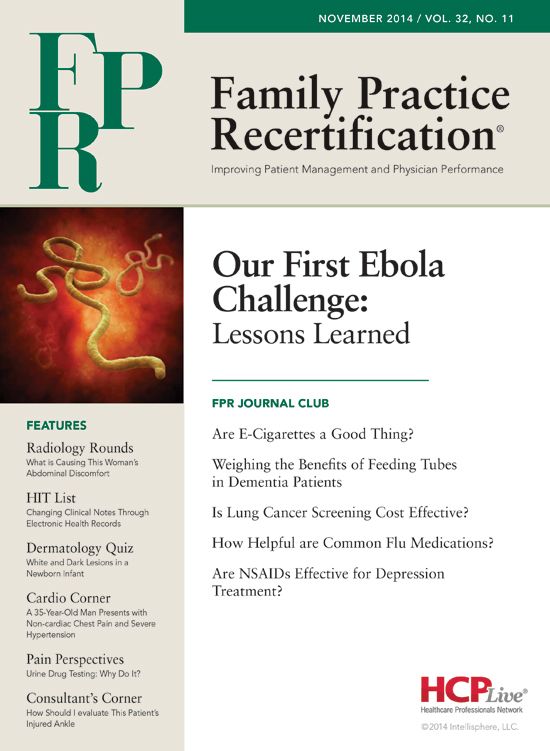Publication
Article
Family Practice Recertification
How Helpful are Common Flu Medicatons?
Author(s):
Two systematic reviews found the efficacy of the two common anti-virals used for influenza to be of questionable benefit.

Frank J. Domino, MD
Review
“Oseltamivir (Tamiflu) and Zanamivir (Relenza) for Influenza in Adults and Children: Outcomes of Two Systematic Reviews.” BMJ 2014; 348:g2545, BMJ 2014; 348:g2547.
Study Methods:
These were systematic reviews that included clinical trials on adults and children who had confirmed or suspected exposure to influenza. The studies had to include time to first alleviation of symptoms, influenza outcomes, complications, admissions to hospital, and adverse events.
Results:
With regards to treatment of adults Oseltamivir reduced time to first alleviation of symptoms by 16.8 hours over placebo. There was no effect in children with asthma, but there was a beneficial effect over placebo in healthy children (mean difference 29 hours). There was no significant benefit in reduction for admission to hospital in adults and sparse data in children for admission.
There was no clear data for prophylaxis. Concerning outcomes in adult trials Oseltamivir reduced “unverified pneumonia risk,” but was not statistically significant in trials that had clear diagnostic criteria for pneumonia. The effect on unverified pneumonia in children and prophylaxis were not found to be significant. There was no significant reduction in the risk of bronchitis, otitis media, sinusitis, or any other complication classified as serious or that would lead to withdrawal from the study.
Concerning adverse effects, Oseltamivir increased the risk of nausea and vomiting with a total of 28 participants requiring treatment for the symptoms. In children Oseltamivir induced vomiting when used for treatment. In prophylaxis trials Oseltamivir reduced symptomatic influenza by those deemed at risk and in households in one study. Overall there was no significant effect for a reduction in transmission. Concerning other adverse effects Oseltamivir increased the risk of psychiatric adverse events. In prophylaxis studies Oseltamivir increased the risk of headaches, renal events, and nausea while on treatment.
For the Zanamivir (Relenza) study Zanamivir reduced the time to first alleviation of symptoms of influenza like illness by just over 14 hours (out of total on average of 6 days of symptoms). Zanamivir did not reduce the risk of self-reported pneumonia or radiologically confirmed pneumonia. The effect on pneumonia in children was also not significant.
There was no significant effect on otitis media or sinusitis in both adults and children, with only a small effect noted for a reduction in bronchitis in adults. In prophylaxis studies symptomatic influenza in individuals was significantly reduced with 51 participants requiring treatment to prevent one case of influenza. In households that were treated prophylactically there was a reduction on symptomatic influenza, but the data was based only two small studies. Prophylaxis in adults reduced unverified pneumonia, but had no effect on pneumonia in children or bronchitis or sinusitis in adults or children.
With regard to the quality of the literature, both studies demonstrated the included trials had a high risk of bias. For example, in the Oseltamivir paper, 40% of the studies adequately reported how patients were randomized, the number of patients included in the studies were considered below the study protocol and of questionable statistical significance. In some studies things like the placebo capsule being a different color than the active treatment capsule allowed both patients and researchers to recognize the difference. For both papers, a significant portion of the studies were funded by the industry that makes the medication and thus open to bias.
Conclusions:
Oseltamivir was effective at treating influenza when initiated within the first 48 hours of symptoms. It came at a cost, in that it increased the risk of nausea, vomiting, headaches, renal complications, and psychiatric syndromes. The reduction was approximately 16.8 hours until symptom resolution over an average a 6 day illness. Oseltamivir also reduced the proportion of symptomatic influenza in those at risk. Concerning Zanamivir, it also reduced the time to symptomatic improvement in adults with influenza illness by about 12 hours. It was not effective in children. Neither drug was found to significantly reduce important complications of influenza, particularly asthma or hospital admission or death.
Discussions:
These two papers provide us with the dramatic limited efficacy of anti-virals for influenza. Complicating their outcomes are the significant risk of bias in almost half of the papers studied including bias by the pharmaceutical manufacturers who funded the studies and would benefit most from a positive outcome.
With regard to best practices in influenza the first is in the diagnosis. Influenza is not a bad cold. It is fever over 100.1°F, associated with anorexia, chills, sweats, malaise, myalgias, headaches, sore throat, and non-productive cough. It is not “a stomach flu” that is it is not associated with nausea or vomiting. Effective treatment requires appropriate diagnosis and initiation of treatment when two critical features are met: 1) treatment can be initiated within 48 hours of symptom onset, and 2) treatment is only indicated in adults and children at higher risk for influenza complications, for example those over the age of 2 or under 65-years-old, pregnant women, nursing home residents, or people with comorbidities like diabetes, heart disease, asthma, and COPD among others. What this implies is that for the vast majority of adults, influenza treatment with anti-viral medication is not indicated.
While also under significant scrutiny the best way to prevent influenza remains the influenza vaccine. The typical vaccine given to most children and adults is the inactivated influenza vaccine that is recommended annually for all persons over 6-months of age. The only contraindication is those who have a severe allergy or anaphylaxis to eggs (developing hives from egg exposure is not a contraindication) or those who have a history of Guillain-Barre Syndrome. The live attenuated influenza vaccine, which is given intra-nasally, is also recommended annually for those persons 2-49 years of age. It is also contraindicated in those with anaphylaxis to eggs, who are immuno-compromised, who are pregnant, who have asthma or other chronic conditions, who have a history of Guillain-Barre Syndrome, or in children who are on a chronic aspirin therapy. Of late, there are many television commercials for a high dose inactivated influenza vaccine. This contains four times the antigens of the traditional inactivated influenza vaccine and is FDA approved for patients over the age of 65. This vaccine is not recommended for or against by the Advisory Committee on Immunization Practices, the body that recommends vaccines for the US population. So its efficacy is still in question and it comes with a higher rate of local reaction to the vaccine.
So what do we do for patients who develop influenza but who do not have comorbidities and would like some treatment? First and most importantly is to treat the symptoms. For fever acetaminophen at 15mg/kg combined with ibuprofen at 10mg/kg at the same time should be given every 6 hours. The combination of the two is highly effective at lowering the fever and the myalgias associated with influenza. Alternating doses of these medications actually increases the risk of an overdose and is recommended against.
For those with significant rhinorrhea, an oral or nasal decongestant used for a short period of time will provide symptomatic relief. Aggressive and adequate hydration is recommended for patients with clear liquids. And most significantly it should be reinforced regarding good hand washing and limiting exposure to others until symptoms have resolved. For those who want to try an intervention, the use of elderberry syrup has been well studied in the literature and found to be as effective if not more effective at anti-virals at shortening influenza symptoms. The dose for adults is typically 15mg QID for 5 days. Elderberry syrup can be purchased at most pharmacies and is safe and effective for adults and children.
Prevention of influenza with an influenza vaccine remains the best mode to prevent adverse outcomes due to influenza. If a patient develops influenza, whether they have been vaccinated or not, and have multiple comorbidities and present within 48 hours, consider using an anti-viral agent. For all, recommend symptomatic relief as well as limiting their exposure to others. Recognizing the significant limits of anti-viral medication will help healthcare providers appreciate their limited efficacy, and should be disseminated to patients so they understand that anti-viral agents are not curative and in fact have limited benefit.
About the Author
Frank J. Domino, MD, is Professor and Pre-Doctoral Education Director for the Department of Family Medicine and Community Health at the University of Massachusetts Medical School in Worcester, MA. Domino is Editor-in-Chief of the 5-Minute Clinical Consult series (Lippincott Williams & Wilkins).
Additionally, he is Co-Author and Editor of the Epocrates LAB database, and author and editor to the MedPearls smartphone app. He presents nationally for the American Academy of Family Medicine and serves as the Family Physician Representative to the Harvard Medical School’s Continuing Education Committee.





